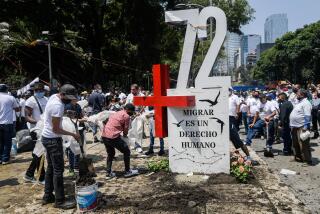Searchers Tunnel Near Boy in Quake Debris : Mexico Hanging on Rescue Word
- Share via
MEXICO CITY — The search was slow and frustrating with no positive results assured, and Thursday many people in this world’s largest city were hanging on every word of progress.
The attempt to rescue 9-year old Luis Ramon Nafarrate, believed to be buried under tons of concrete, brick and wood, has become a cliff-hanger among a long string of dramatic rescue efforts that have followed the earthquake that shattered much of central Mexico City on Sept. 19.
The odds on Luis Ramon’s survival are long. If he is alive, he has spent more than 14 days beneath a collapsed wing of an old apartment building.
Still, university technicians insisted Thursday that they have heard young Luis Ramon tapping on pipes or concrete. Rescue teams dug into a dangerously unstable mounds of rubble to look for him.
Luis Ramon’s grandfather is also believed to be buried there, and the odds on his survival are even longer. Searchers think that Luis Ramon has survived, and perhaps not his grandfather, because of a tapped-out answer to a shouted question.
“We asked if he was Monchito,” said the boy’s father, Mauricio, using the boy’s nickname. “One tap was ‘yes,’ two ‘no.’ He tapped once.”
Late Thursday afternoon, workers toiled at extending five tunnels into the debris.
Like many another tale of rescue in the wake of the earthquake, this one features stops and starts, organizational failures and ego clashes. Yet it is filled with hope.
The single-minded campaign of family members to recover their loved ones, dead or alive, has kept the effort going.
The saga of Luis Ramon began as a rest stop on a cross-country trip. Mauricio Nafarrate, a hotel maintenance worker, was transferring from the Cozumel resort on the Caribbean coast to Zihuatanejo on the Pacific.
The family, including Luis Ramon’s mother, Sonia Maldonado de Nafarrate, and two brothers, were traveling together. They decided to overnight in the apartment of grandfather Luis Maldonado at No. 148 Venustiano Carranza St. in the old part of downtown Mexico City.
Maldonado’s apartment was in a three-story building of stone and mortar. A plaque by the arched main door said it was the birthplace of Mariano Matamoros, an independence war hero, which would make the building about 200 years old.
When the earth shook at 7:18 a.m. Sept. 19, Luis Ramon and his grandfather were still asleep. Building No. 148 held up, but next door, a much newer, eight-story store and warehouse, collapsed, each floor slamming down into the next.
The warehouse also listed sideways, and several floors slid onto No. 148 and into the building’s old courtyard.
Luis Ramon’s bedroom on the second floor sank a story and was buried by about 20 feet of shattered wall and concrete floor. The rest of No. 148 was virtually undamaged, and everyone else living there fled to safety.
Calamities immediately began to multiply. A household gas tank exploded and ignited. Firemen came, but without a water tank. The firemen returned and extinguished the blaze. But the rubble shifted and slid, further burying the room where Luis and his grandfather had slept.
Family and friends from the neighborhood and all over Mexico City gathered quickly. They said they heard tapping on pipes and began to pull bricks and beams away by hand.
“For the first four days, we were the only ones working to rescue. No rescue teams came,” said Armando Angulo, one of Luis Ramon’s uncles.
The family, like hundreds of others in Mexico City, appealed on television and radio for assistance. On the fourth day after the quake a team of French experts brought trained dogs to sniff the rubble. They turned up nothing and left.
“The problem was, the French were inspecting the building next door. They didn’t believe anyone could survive the collapse,” Angulo said.
Neighbors and family insisted they could hear noises in the quiet of the night. They kept digging. Foreign rescue teams came and went.
Some left because debris was loose and dangerous and they feared digging. Others left because they were called to sites where reports of greater numbers of survivors promised more success in less time.
“We couldn’t get a regular rescue going,” Angulo said.
Last Saturday, a Venezuelan team with sensitive microphones picked up noises inside No. 148, but only on Monday did non-stop rescue efforts begin.
All the while, occasional tapping gave hope.
By Tuesday, the possible rescue of Luis Ramon had become a celebrated cause. Volunteer teams vied to take part in the rescue. The Red Cross argued with other volunteer groups over where and how to build a tunnel. At least three men claimed to be in charge of rescue.
Daring workers from Mexico’s silver mines and oil fields slipped into newly dug tunnels, strengthening unstable sides with wooden four-by-fours.
One of these so-called moles, Marcos Efren Zarinana, has become a national hero. Using his new nickname, The Flea, Zarinana alternated crawls into the rubble with interviews on television.
About midnight Wednesday, two groups of rescuers, all wearing surgical masks to protect them from dust, began to dig new tunnels. By 8:30 a.m. Thursday, the tunnels met. Each had bypassed the boy.
The digging, with picks, shovels and chisels, continued. Crumbling occasionally set back progress.
“We’re digging centimeter by centimeter,” said Decarlo Malban, an Argentine architect and family friend.
Technicians from the National Autonomous University said that they have detected breathing, using ultra-sensitive sound equipment.
“The heartbeat sounds strong, but the breathing is increasingly light,” said Alfonso Sanchez, a lawyer and volunteer rescue worker.
More to Read
Sign up for Essential California
The most important California stories and recommendations in your inbox every morning.
You may occasionally receive promotional content from the Los Angeles Times.










